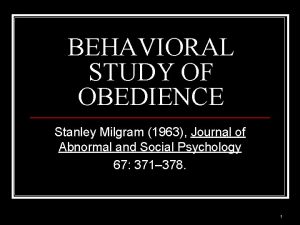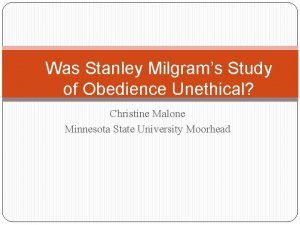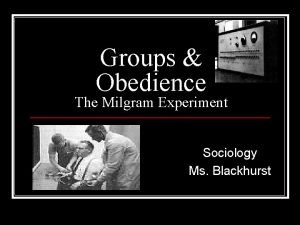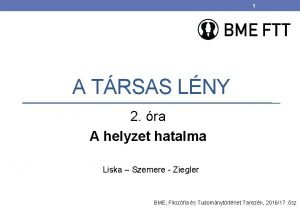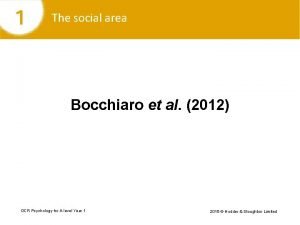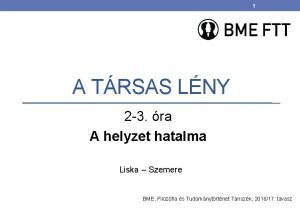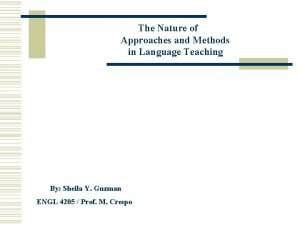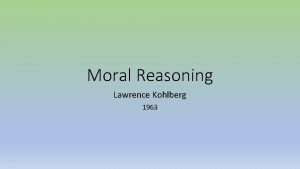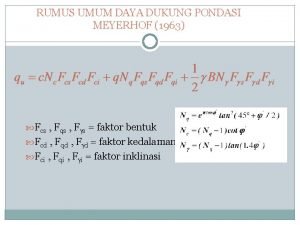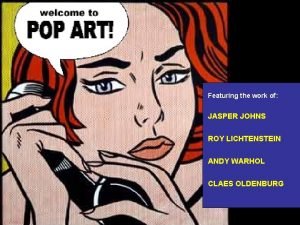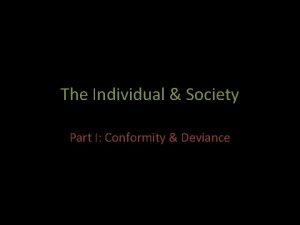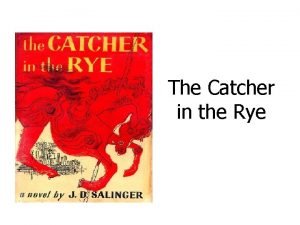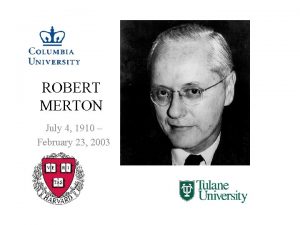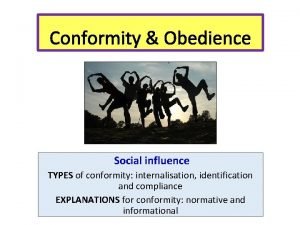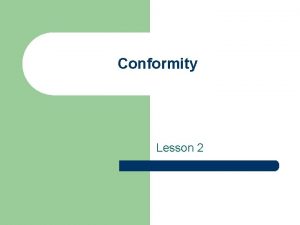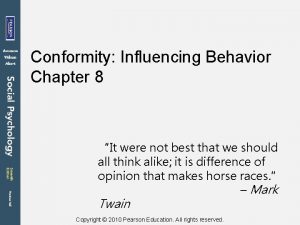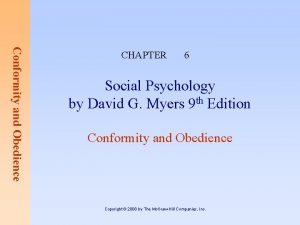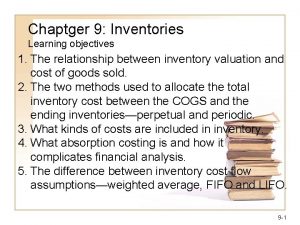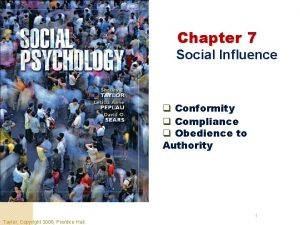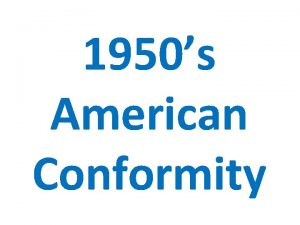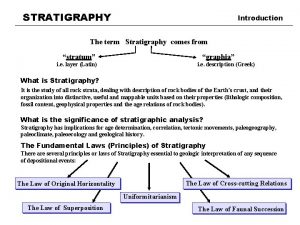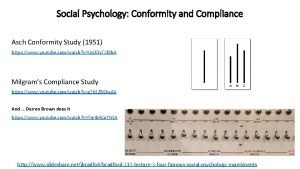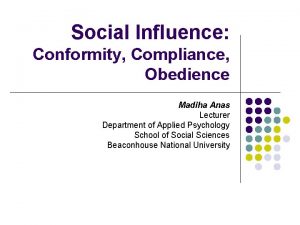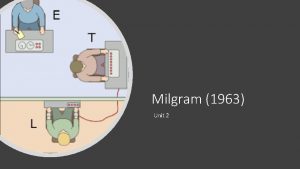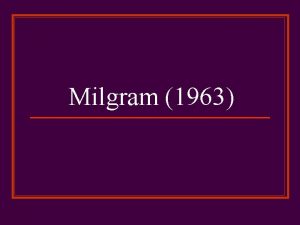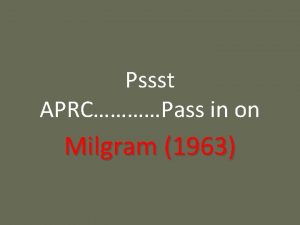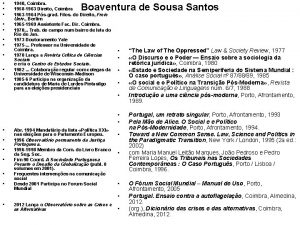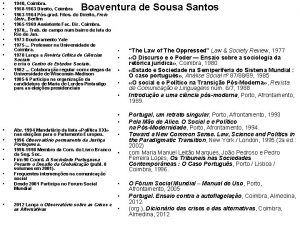Review conformity Answer Answer Answer Milgram 1963 O



































































































































- Slides: 131

Review conformity

Answer


Answer




Answer

Milgram (1963) O b e d i Key words: Obedience Agentic State Autonomous state Legitimacy of authority Situational variables External explanations Internal explanations Authoritarian personality To understand what is meant by obedience • To be able to describe the different explanations of obedience • To evaluate using research, explanations of obedience e n c e •

Specification 1. 1 Types of conformity internalisation, identification and compliance. 1. 2 & 1. 3 Explanations for conformity informational social influence and normative social influence, and variables affecting conformity including group size, unanimity and task difficulty as investigated by Asch. 1. 4 Conformity to social roles investigated by Zimbardo 1. 5 Explanations for obedience Agentic state and legitimacy of authority, and situational variables affecting obedience including proximity, location and uniform, as investigated by Milgram. Dispositional explanations for obedience the Authoritarian Personality Explanations of resistance to social influence including social support and locus of control Minority influence including reference to consistency, commitment and flexibility The role of social influence processes in social change application of the above research to examples of social change e. g. suffragettes, Rosenstrasse Protest, racial equality, abolition of slave trade etc

What would you do? Would you obey? Why?

What would you do? Would you obey? Why? A fireman in uniform approaches you in the street and tells you to cross to the other side of the street immediately

What would you do? Would you obey? Why? Notices tell you to keep off the grass

What would you do? Would you obey? Why? You are a soldier, and your commanding officer tells you to run towards the enemy even though they are firing directly at you

What would you do? Would you obey? While on holiday in a country with a very different culture and language from yours, a member of the hotel staff tells you that you must write in a book where you are going every time you leave the hotel

What would you do? Would you obey? Why? You volunteer to contribute ideas to a book, for which you’re being paid, and in your first session the tutor tells you to step on snails and then write about the experience

What would you do? Would you obey? Why? Someone in year 10 tells you that the Head wants to see you now – if you go, you’ll be late for an exam

What would you do? Would you obey? Why? At work, your boss tells you that if you steal money out of your colleague’s locker, which they always leave open, it will teach them a valuable lesson about taking care of their property

Behavioural Study of Obedience by Stanley Milgram (1963)









Milgram Shockingly good behaviour

Background: Obedience to Authority • Research assistant to Solomon Asch (Conformity) • How far will people go in the name of obedience? • Case study of Eichmann http: //www. youtube. com/watch? v=5 x 0 qn. EZ 0 n. WY&safe=active • Explore the Germans are Different Hypothesis. • Individual Vs Situational explanations.

Background: My Lai Massacre http: //www. youtube. com/watch? v=VWchy 6 yk. Nn. Q&safe=active Vietnam 1970. Troops ordered to round up all inhabitants of the village My Lai and ‘waste them’. Everyone was killed.

“Germans are different” hypothesis • The hypothesis has been used by historians to explain the systematic destruction of the Jews by the Third Reich. • Milgram set out to test whether Germans have a basic character flaw which is a readiness to obey authority without question, no matter what outrageous acts the authority commands.

Aim • Investigate what level of obedience would be shown when subjects were told by an authority figure to administer electric shocks to another person.

The participants • The experimenter • The learner • The teacher

Method: Data: Laboratory experiment? Controlled Observation. A record of the maximum level of shock the subject administered to a victim. Post experiment interviews, tests and attitude measures. Recordings of the sessions. Photographs. Notes of unusual behaviour.

Apparatus Two rooms. One shock generator – 30 switches from 15 – 450 v. Descriptions of the intensity (slight, intense, danger). Chair with straps. Tape recorder. Two male confederates.

Milgram’s experimental set-up

The Shock Generator (from 15 volts to 450 volts)

Sample • Participants were obtained from a newspaper advertisement. • There were 40 males aged 20 -50 who came from a variety of backgrounds and careers. • They were told they would be paid $4. 50

Procedure • Study was conducted at Yale University. • is Theabout researchers had to. Science convince the participants of the “It learning. does not know reality of the situation. They did this by: much about negative reinforcement on learning. Negative is getting 1. The participants tookreinforcement part one at a time. punished when something wrong. In 2. A cover story wasyou usedget to justify the procedure. 3. Slips of paper were from a hat to determine this case, it will bedrawn an electric shock. ” roles. This was fixed so participants were always the teacher. 4. Participants were told that no permanent tissue damage would be caused.

Procedure (2) The task involved the teacher reading a series of word pairs to the learner. No shocks given to learner but teacher experienced a The teacher then read the first word of a pair, and then a variety of small test shock from the equipment beforehand. other words, one of which was originally paired with the first word. The learner had to indicate which of the four words had been paired Atwith 300 the volts learner pounded on the wall. first the word. If the learner got the answer wrong the teacher had to administer a small electric shock by flicking a switch. The teacher was told for each further mistake the shocks would increase by 15 volts and to treat no answer as a wrong answer.

Procedure (3) DEBRIEF: tape recordings of feedback were Standardised given to the teacher. At the end of the study the teacher was Any attempt to ask questions to the researcher was reunited the learner. met by thewith following prods. Milgram interviewed the subjects. Carried out a test on possible long term effects and 1. ensured “Please the continue” participants left the laboratory in 2. a“The requires that you go on” stateexperiment of well-being. 3. “It is absolutely essential that you continue” 4. “You have no other choice, you must go on”

Would Milgram’s participants obey? • Do you think the American participants would obey the experimenter and deliver electric Prior to theto research, Milgram interviewed shocks another human being? psychology students and asked them whether they would • administer What %aoffatal participants you think said would shock. 1. 2%do of participants they would. the full (and fatal) 450 volt shock? deliver • Write your percentage estimate and compare with a neighbour.

Milgram’s results Quantitative • All subjects administered shocks up to 300 volts. (5 refused to go further) • 62. 5% of Milgram’s participants delivered the full (and fatal) 450 volt shock. • - Therefore 15 participants in total were labelled as defiant and 26 obeyed. Qualitative • Objective observers noticed that most participants groaned, protested, fidgeted, argued and in some cases, were seized by fits of nervous, agitated giggling.

Discussion Obedience was much higher than expected. Why? suggests conflict – of. Yale. two competing demands • Milgram Prestigious University • Subjects believed the learner had volunteered and Belief of do not harm Vs Tendency to obey orders. the allocation was by chance. • Subjects had a Individual social contract – being paid. Vs Situational • Subjects were told that shocks were not harmful. • No past experience to guide behaviour. • A small increment each time, no obvious point to stop. Those who did – did so after 300 volts.

An explanation for obedience? • Milgram suggested: • “They are somehow engaged in something from which they cannot liberate themselves. They are locked into a structure, and they do not have the skills or inner resources to disengage themselves. ” The Goebbels family – Frau Goebbels poisoned all six of her children in the final days of the war. Josef Goebbels shot his wife dead and then shot himself.

Killing in the name of…. Gas ovens at Auschwitz. Birkenau Rwandan genocide Vietcong dead

WHY?

Were the Germans different? • The answer is “No”. • Milgram’s experimental results in 1963 provide evidence that atrocities can happen ANYWHERE. • He argued that there are two reasons why people obey.

Theory of conformism • The theory of conformism is based on Solomon Asch's work, describing the fundamental relationship between the group of reference and the individual person • "A subject who has neither ability nor expertise to make decisions, especially in a crisis, will leave decision making to the group and its hierarchy. The group is the person's behavioural model. " • So, the SS troops followed the orders of the officers. l. Reichsfuhrer of the SS: Heinrich Himmler.

Agentic State theory Agentic state theory, according to Milgram, “The essence of obedience consists in the fact that a person comes to view himself as the instrument for carrying out another person's wishes, and he therefore no longer sees himself as responsible for his actions. Once this critical shift of viewpoint has occurred in the person, all of the essential features of obedience follow. " Holocaust Memorial

Milgram’s reflections “The social psychology of this century reveals a major lesson: often it is not so much the kind of person a man is as the kind of situation in which he finds himself that determines how he will act. " (1974) “Some people are psychologically incapable of disengaging themselves. But that doesn’t relieve them of the moral responsibility. ” (1970)

What can we learn?

French TV Show • • http: //news. sky. com/skynews/Home/Strange-News/French-TV-Experiment-Which-Encouraged-Players-To -Torture-Another-Contestant-Condemned-In. France/Article/201003315575334? lpos=Strange_News_First_Home_Article_Teaser_Region_0&lid=ARTICL E_15575334_French_TV_Experiment_Which_Encouraged_Players_To_Torture_Another_Contestant_Con demned_In_France http: //timescorrespondents. typepad. com/charles_bremner/2010/03/frances-shock-game-show. html

GRAVER Time … In groups complete a section of GRAVER. Those doing ethics – use your book to consider: Deception/ Informed Consent. Right to Withdraw. Inducement Harm.

Supporting evidence • Hofling (1966) Nurse-Physician Relationship. Dr Smith – asks 22 nurses to administer 20 mg of an unfamiliar drug. The box said 10 mg was a safe dose. 95. 4% obeyed without hesitation.

Contemporary Research: Would similar results be found today? Burger (2009) A more ethical replication. Screening process. Told they could withdraw. Clinical psychologist oversaw procedure. 70 male and female patients. 70% Obedience rate – no difference between men and women.

1. 6 Explanations for Obedience The Agentic state Situational Variables Dispositional Explanation

Agentic state The individual sees themselves as an agent of an authority figure who is seen as ultimately responsible for an individuals actions. We are socialised to recognise legitimate authority and to obey without question for the greater good. • Milgram Variation – Remote authority, the orders given over the phone. Obedience declined to 20. 5%.

Situational Variables Proximity Location Uniform

Dispositional Explanation Authoritarian Personality

Home Learning (Milgram) 1. �Explain how proximity and location can affect obedie + 2 marks) 2. Yolande dropped a crisp packet but did not pick it up when asked to do so by a member of the public but picked it up when challenged by a security guard. Why? (3 marks) 1. Outline and evaluate the findings and conclusions of one study into obedience. (6 marks) 2. Discuss two explanations for obedience. (16 marks)

Home learning task Using the teachers feedback as well as your own • Describe and evaluate two studies of social influence. [12 marks]- one study must be Milgram! – What are the key words in this question? • Describe: Give an account of. • Evaluate: Judge from the available evidence. – Which studies could you include? Remember to read ahead!! Minority influence (p 41 -47)

Quick reminder of what to include Ao 1 • Likely studies include: – Milgram – Other relevant studies • Describe the procedure/method, findings and/or conclusions • You can also get credit for referring to variations or replications of the original study.

Quick reminder of what to include Ao 3 • The mark scheme refers to effective evaluation. • What is that? • Two evaluation points per study, that are clearly explained using psychological language. • For example: It can be argued that Zimbardo’s simulated prison study lacks reliability. This is because the results have not been replicated. When a similar study (BBC Prison Study) was completed, albeit with different ethical protocols, the results were very different.

Who wants to be a Milgramaire!

Where was Milgram’s study held? A. Yale University C. Aquinas College B. Manchester University D. Harvard University

£ 1, 000 £ 500, 000 £ 250, 000 £ 125, 000 £ 64, 000 £ 32, 000 £ 16, 000 £ 8, 000 £ 4, 000 £ 2, 000 £ 1, 000 £ 500 £ 300 £ 200 £ 100

How was the ‘teacher’ selected? A. Lucky Dip B. A fixed draw where the confederate always got the learner role. C. Whoever threw the highest D. Whoever could touch their nose number on a dice with their tongue.

£ 1, 000 £ 500, 000 £ 250, 000 £ 125, 000 £ 64, 000 £ 32, 000 £ 16, 000 £ 8, 000 £ 4, 000 £ 2, 000 £ 1, 000 £ 500 £ 300 £ 200 £ 100

What did the teacher have to do? A. Keep dancing or get an electric shock C. Issue the learner electric shocks when answers were incorrect. B. Shock the learner randomly D. Shock the learner when they answered correctly.

£ 1, 000 £ 500, 000 £ 250, 000 £ 125, 000 £ 64, 000 £ 32, 000 £ 16, 000 £ 8, 000 £ 4, 000 £ 2, 000 £ 1, 000 £ 500 £ 300 £ 200 £ 100

What were the participants told the study was about? A. That it was a study on Learning and Punishment B. That it was looking at memory skills C. That it was a study about how to kill D. That it was a study about hand people without blame eye coordination.

£ 1, 000 £ 500, 000 £ 250, 000 £ 125, 000 £ 64, 000 £ 32, 000 £ 16, 000 £ 8, 000 £ 4, 000 £ 2, 000 £ 1, 000 £ 500 £ 300 £ 200 £ 100

What signs of nervousness did some of the participants show? A. C. Performing hand stands Hiccups B. Talking to their imaginary friend D. Laughing

£ 1, 000 £ 500, 000 £ 250, 000 £ 125, 000 £ 64, 000 £ 32, 000 £ 16, 000 £ 8, 000 £ 4, 000 £ 2, 000 £ 1, 000 £ 500 £ 300 £ 200 £ 100

How were the participants selected? A. B. They volunteered in response to a C. D. They were picked off the street They had to participate as part of their course at College. They were selected by the government. newspaper advertisement.

£ 1, 000 £ 500, 000 £ 250, 000 £ 125, 000 £ 64, 000 £ 32, 000 £ 16, 000 £ 8, 000 £ 4, 000 £ 2, 000 £ 1, 000 £ 500 £ 300 £ 200 £ 100

How much were the participants paid? A. $4. 50 C. $1 B. $100 D. $9. 50

£ 1, 000 £ 500, 000 £ 250, 000 £ 125, 000 £ 64, 000 £ 32, 000 £ 16, 000 £ 8, 000 £ 4, 000 £ 2, 000 £ 1, 000 £ 500 £ 300 £ 200 £ 100

At what shock level did the ‘learner’ react and shout? A. 100 volts C. 15 Volts B. 300 Volts D. 450 Volts

£ 1, 000 £ 500, 000 £ 250, 000 £ 125, 000 £ 64, 000 £ 32, 000 £ 16, 000 £ 8, 000 £ 4, 000 £ 2, 000 £ 1, 000 £ 500 £ 300 £ 200 £ 100

Which of the following was a Prod used by the experimenter to get the participant to continue: A. B. “Its shock or get shocked” C. D. “You cannot leave until you “If you don’t shock him I won’t be your friend” “The experiment requires that you continue” have finished”

£ 1, 000 £ 500, 000 £ 250, 000 £ 125, 000 £ 64, 000 £ 32, 000 £ 16, 000 £ 8, 000 £ 4, 000 £ 2, 000 £ 1, 000 £ 500 £ 300 £ 200 £ 100

What percentage of the participants went all the way to 450 Volts? A. 65% C. 100% B. 20% D. 5%

£ 1, 000 £ 500, 000 £ 250, 000 £ 125, 000 £ 64, 000 £ 32, 000 £ 16, 000 £ 8, 000 £ 4, 000 £ 2, 000 £ 1, 000 £ 500 £ 300 £ 200 £ 100

What Voltage did the participant get shocked with to show the shocks were real? A. 60 Volts C. 5 Volts B. 45 Volts D. 100 Volts

£ 1, 000 £ 500, 000 £ 250, 000 £ 125, 000 £ 64, 000 £ 32, 000 £ 16, 000 £ 8, 000 £ 4, 000 £ 2, 000 £ 1, 000 £ 500 £ 300 £ 200 £ 100

How many participants were there? A. 50 Men and Women C. 40 Men B. 100 Men D. 40 Men and Women

£ 1, 000 £ 500, 000 £ 250, 000 £ 125, 000 £ 64, 000 £ 32, 000 £ 16, 000 £ 8, 000 £ 4, 000 £ 2, 000 £ 1, 000 £ 500 £ 300 £ 200 £ 100

What area were the participants from? A. New Haven C. New Zeland B. New York D. Old Haven

£ 1, 000 £ 500, 000 £ 250, 000 £ 125, 000 £ 64, 000 £ 32, 000 £ 16, 000 £ 8, 000 £ 4, 000 £ 2, 000 £ 1, 000 £ 500 £ 300 £ 200 £ 100

How many participants were there? A. 50 Men and Women C. 40 Men B. 100 Men D. 40 Men and Women

£ 1, 000 £ 500, 000 £ 250, 000 £ 125, 000 £ 64, 000 £ 32, 000 £ 16, 000 £ 8, 000 £ 4, 000 £ 2, 000 £ 1, 000 £ 500 £ 300 £ 200 £ 100

Who wasn’t allowed to participate in the experiment? A. People with grey hair C. People over 6 Feet tall B. College Students D. Overweight people


Evaluating Milgram

Questions • Identify 2 controls in the Milgram experiment into obedience (2 marks) • Outline how qualitative data was gathered in the study (4 marks) • Give an example of qualitative data gathered in the study (2 marks)

Controls in the experiment • Standardisation refers to how experimenters try to keep the test conditions the same for all participants. • It is a method of controlling what are called situational variables. • The controls are everything that is kept the same in the experiment. Identify 2 controls of the experiment

Examples of controls… 1. The instructions given to the PP 2. The learner and experimenter figures were kept the same (dress too) 3. The learners taped responses to the shocks were the same 4. The wording of and sequence of the verbal prods Note: An examiner would not consider it significant to say a control was ‘the room it was conducted in’. • These all ensured that situational variables were controlled. • They improve the reliability of the study (because the method is therefore consistent).

Qualitative data • • • Crying Laughing – nervous laughter Sweating Trembling Stuttering Groaning Lip-biting Digging nails into their hands 3 subjects had violent convulsions

Generalisability • However, when Milgram tested women, they gave the same level of obedience. • White, middle class males aged 20 – 40. • Androcentric • A Dutch study by Meeus • Ethnocentric & Raaijmakers (1986) showed that willingness to obey wasn’t unique to the American culture.

Reliability Whether the study was standardised enough to allow someone else to replicate it and obtain similar results.

Reliability • Controlled conditions of a laboratory setting. • Milgram tested his participants one at a time and followed a standardised procedure. Every participant therefore had a similar experience. • Many other researchers have replicated Milgram’s study and used his procedure, and in each case, they have obtained very similar results to those obtained by Milgram. (Although, not a true experiment as no IV).

Application • Demonstrates the power of situational factors. • Helps us understand atrocities such as holocaust – why good people go along with bad actions.

Validity Internal Validity (design validity) Ecological Validity Can we believe the findings? Is the behaviour like real life. Are there any reasons they might not be true? How realistic is the study? Are there any design faults which affect the results.

Internal Validity By allowing the participants to meet the ‘learner’ and to experience a 45 V shock, Milgram tried to ensure that his procedure was believable. Since participants displayed signs of distress and reported that they thought the final shocks would have been ‘extremely painful’, Milgram argued that they had believed in the experimental situation. Demand characteristics. When Milgram asked his participants if they believed they were administering shocks only 2. 4% claimed to be certain. How valid is this result? Why did they show signs of distress?

Ecological Validity • Milgram set the study at • Artificial nature of the a prestigious university. laboratory. Is this It was a believable piece measuring how people of research. behave in a lab doing unusual activities.

Ethics Fully informed consent Deception Right to Withdraw Protection from Harm

Ethical guidelines -Fully informed consent • Participants were told that the study was about the effect of punishment on learning and that punishment would be administered through giving electric shocks to a ‘learner’. • Participants were deceived by a cover story – no full consent gained. • Milgram would argue this is necessary.

Ethical guidelines -Deception • Participants should not be deceived as to the true nature of the study – if they are, they must be fully debriefed afterwards • Milgram staged the draw to make it appear that the allocation of participants to being a ‘learner’ and or a ‘teacher’ was completely by chance. Participants also were led to believe the shocks were real and the cries they heard were coming from the ‘learner’. Milgram did debrief participants after the study and did a followup study one year later.

Ethical guidelines -Right to withdraw • Participants should feel free to leave the study at any point and can request that their results are destroyed • If participants were reluctant to administer the shocks, they were given verbal ‘prods’ by the experimenter to encourage them to continue. • 65% of participants in the original study did go on to give up to the maximum shock level. However, this does mean that 35% of participants did not.

Ethical guidelines -Protection from harm / distress • Participants should not be made to experience anything that they wouldn’t normally encounter in their everyday lives • Milgram defended his study by saying that he couldn’t have foreseen the severity of stress experienced, and was relieved that results from the follow-up study indicated that participants had not suffered any long term harm. 84% reported that they were very glad to have taken part in the experiment, with only 1. 3% very sorry to have taken part.

Research Method Observation Experiment Quantitative Qualitative

Background (2 marks) Aim (2 marks) Data collection (6 marks) Procedure (6 marks) Ethical Issues Results / Findings Improvements and implications

VALIDITY IS THE RESEARCH MEASURING WHAT IT AIMED TO MEASURE?

Orne & Holland (1968) criticise Milgram’s study for lack of: 1. Experimental (Internal) Validity 2. Ecological (External) Validity 1. EXPERIMENTAL (INTERNAL) VALIDITY… …is a measure of whether experimental procedures actually work and the results are genuine! e. g. • The controls (did anything else affect PPs? ) • The measurements (accurate & meaningful? ) • The demand characteristics (could PPs work out the aims & change their behaviour? )

2. Ecological (External) Validity… …The extent to which the study’s results can be generalised beyond the research situation e. g. – The setting (was it realistic? ) – The sample (was it representative? What about females, or the elderly? )

LOW v HIGH VALIDITY GAME

EXPERIMENTAL (INTERNAL) VALIDITY Milgram argued that the distress shown by the PPs taking part was due to feeling they had to follow the demands of an authority figure and to be obedient. HIGH VALIDITY!

The study was repeated many times using the same procedure! HIGH VALIDITY!

Participants may have only shocked the learner as they were paid to take part and were bound to a contract. They were not being obedient LOW INTERNAL VALIDITY!

Orne and Holland Argue that the participants don’t believe the experiment is real, they don’t think they are really hurting the learner LOW INTERNAL VALIDITY!

Milgram asked participants after the study (using a questionnaire) if they thought it was fake, they all responded that they thought it was real. HIGH INTERNAL VALIDITY!

Ecological (external) validity Research conducted in other countries found varying levels of obedience: Holland, Germany and Austria were higher than Britain and Australia (however procedure may have varied so comparison difficult) LOW ECOLOGICAL VALIDITY!

Rank and Jacobson carried out an obedience study on nurses on a known drug and they were not obedient which questions Milgram’s findings LOW ECOLOGICAL VALIDITY

Hoffling repeated the study in a real life setting in a hospital and got similar results showing obedience is high in real life also HIGH ECOLOGICAL VALIDITY!

When Milgram repeated his study in run down offices the obedience rate was lower suggesting the setting affected obedience LOW ECOLOGICAL VALIDITY!

When study was conducted with females, similar results were shown! HIGH ECOLOGICAL VALIDITY!

WHY DO OEDIENCE LEVELS VARY IN THE STUDIES LOOKED AT SO FAR…. ?

Create your own way of explaining the following reasons for obedience. . 1. 2. 3. 4. 5. 6. 7. Legitimate authority Gradual commitment Contractual Obligation Altering meaning of situation The genetic shift Buffer Personality Factors

Independent behaviour ‘Going against the pressure to conform or obey so that behaviour is not altered. ’ Why do you think this might occur?
 What is obedience in psychology
What is obedience in psychology Behavioral study of obedience
Behavioral study of obedience Chapter review motion part a vocabulary review answer key
Chapter review motion part a vocabulary review answer key Stanley milgram obedience experiment unethical
Stanley milgram obedience experiment unethical Stanley milgram
Stanley milgram Who is stanley milgram
Who is stanley milgram El experimento de milgram
El experimento de milgram The milgram studies
The milgram studies Variation of milgram's study
Variation of milgram's study Paradoxe de milgram
Paradoxe de milgram Milgram agency theory
Milgram agency theory Obedience sociology
Obedience sociology Female obedience
Female obedience Milgram ecological validity
Milgram ecological validity Stanley milgram
Stanley milgram Naffziger testi
Naffziger testi Milgram kísérlet film
Milgram kísérlet film How does bocchiaro link to the social area
How does bocchiaro link to the social area Sharon milgram nih
Sharon milgram nih Milgram kísérlet
Milgram kísérlet Milgram
Milgram Stanley milgram
Stanley milgram Milgram experiment
Milgram experiment Milgram experiment
Milgram experiment Otokinetik etki deneyi
Otokinetik etki deneyi Milgram
Milgram Sharon milgram
Sharon milgram Edward anthony 1963
Edward anthony 1963 Brown bomber from the watsons go to birmingham
Brown bomber from the watsons go to birmingham Edward anthony 1963
Edward anthony 1963 The birmingham campaign 1963
The birmingham campaign 1963 Georges braque le jour
Georges braque le jour Wickens
Wickens R v gill 1963
R v gill 1963 Kohlberg 1963
Kohlberg 1963 Method vs approach
Method vs approach Becka konvencija o konzularnim odnosima 1963
Becka konvencija o konzularnim odnosima 1963 Equal pay act 1963 summary
Equal pay act 1963 summary Alfred du bois
Alfred du bois Watsons of dayton
Watsons of dayton Brown bomber the watsons go to birmingham
Brown bomber the watsons go to birmingham Strenge winter 1963
Strenge winter 1963 D-day birmingham 1963
D-day birmingham 1963 Air pump boyle
Air pump boyle Nobel prize 1963
Nobel prize 1963 Nobel prize 1963
Nobel prize 1963 Omnicom 1963
Omnicom 1963 Robert morris document 1963
Robert morris document 1963 Rumus daya dukung tanah meyerhof
Rumus daya dukung tanah meyerhof 1963-1970
1963-1970 Gingival index loe and silness 1963
Gingival index loe and silness 1963 1980-1963
1980-1963 Vin 1963
Vin 1963 Gullahorn and gullahorn (1963) w curve
Gullahorn and gullahorn (1963) w curve Jasper johns
Jasper johns Anglo-conformity
Anglo-conformity Norms of morality
Norms of morality Example of conformity deviance
Example of conformity deviance The catcher in the rye meaning
The catcher in the rye meaning Dispositional attribution ap psychology
Dispositional attribution ap psychology In asch's study which of these lowered conformity rates
In asch's study which of these lowered conformity rates Two types of conformity
Two types of conformity Elevator conformity experiment
Elevator conformity experiment Conformity; innovation; ritualism; retreatism; rebellion *
Conformity; innovation; ritualism; retreatism; rebellion * Conformity; innovation; ritualism; retreatism; rebellion *
Conformity; innovation; ritualism; retreatism; rebellion * Ped harmonised standards
Ped harmonised standards Values and norms examples
Values and norms examples Informational conformity definition
Informational conformity definition Premoral stage
Premoral stage Dollar value lifo
Dollar value lifo Cultural diversity and conformity section 2 answers
Cultural diversity and conformity section 2 answers Cultural diversity and conformity section 1
Cultural diversity and conformity section 1 Conformity psychology
Conformity psychology Internalisation conformity definition
Internalisation conformity definition Asch conformity experiment
Asch conformity experiment Informational social influence psychology definition
Informational social influence psychology definition Compliance vs conformity
Compliance vs conformity What is conformity
What is conformity Authority conformity
Authority conformity Conformity and obedience
Conformity and obedience Conformity and obedience
Conformity and obedience Conformity bias
Conformity bias The lifo conformity rule
The lifo conformity rule Compliance vs conformity
Compliance vs conformity Tendency to conform
Tendency to conform Hugh hefner
Hugh hefner 1950s conformity and counterculture
1950s conformity and counterculture Cultural diversity and conformity section 3
Cultural diversity and conformity section 3 What is conformity?
What is conformity? Conformity vs nonconformity
Conformity vs nonconformity Conformity and alienation
Conformity and alienation Cultural diversity and conformity chapter test form a
Cultural diversity and conformity chapter test form a Eti conformity services
Eti conformity services Cultural diversity and conformity section 2
Cultural diversity and conformity section 2 Ambiguous social influence
Ambiguous social influence Hpe declaration of conformity
Hpe declaration of conformity Conformity orientation
Conformity orientation Conformity
Conformity Onlap toplap downlap
Onlap toplap downlap Relative age
Relative age Asch conformity experiment results
Asch conformity experiment results Cultural diversity and conformity section 1
Cultural diversity and conformity section 1 Compliance psychology definition
Compliance psychology definition Obedience psychology
Obedience psychology Government conformity
Government conformity Interpersonal accord and conformity
Interpersonal accord and conformity Persian royal road
Persian royal road Cultural diversity and conformity section 1
Cultural diversity and conformity section 1 Writ of certiorari ap gov example
Writ of certiorari ap gov example Narrative review vs systematic review
Narrative review vs systematic review Prisma diagram example
Prisma diagram example Narrative review vs systematic review
Narrative review vs systematic review Trigonometry isosceles triangle
Trigonometry isosceles triangle Area and volume vocabulary review answer key
Area and volume vocabulary review answer key Spanish final exam review packet answer key
Spanish final exam review packet answer key Chapter 18 review chemical equilibrium section 2 answer key
Chapter 18 review chemical equilibrium section 2 answer key Section 15-2 evidence of evolution answer key
Section 15-2 evidence of evolution answer key Section 38-1 review echinoderms answer key
Section 38-1 review echinoderms answer key The tragedy of romeo and juliet test review
The tragedy of romeo and juliet test review Section 19-1 review understanding populations
Section 19-1 review understanding populations Mantle magma
Mantle magma Words related to the greek or latin root/affix calc-stone
Words related to the greek or latin root/affix calc-stone Modern chemistry chapter 9
Modern chemistry chapter 9 Chapter 12 review solutions section 2 answers
Chapter 12 review solutions section 2 answers Hydrology unit study guide
Hydrology unit study guide What does the notation tt mean to geneticists?
What does the notation tt mean to geneticists? Class holothuroidea examples
Class holothuroidea examples Describing and measuring motion answer key
Describing and measuring motion answer key Chemistry review answer key
Chemistry review answer key Chapter 18 review chemical equilibrium section 3 answer key
Chapter 18 review chemical equilibrium section 3 answer key Biology keystone review packet answer key
Biology keystone review packet answer key Textile machinery apush
Textile machinery apush

